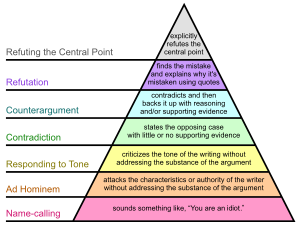Hierarchy of disagreement
 From RationalWiki - Reading time: 3 min
From RationalWiki - Reading time: 3 min
| Cogito ergo sum Logic and rhetoric |
| Key articles |
| General logic |
| Bad logic |
The hierarchy of disagreement is a concept proposed by computer scientist Paul Graham![]() in his 2008 essay How to Disagree.[1] Graham's hierarchy has seven levels, from name calling
in his 2008 essay How to Disagree.[1] Graham's hierarchy has seven levels, from name calling![]() to "Refuting the central point". The point of the concept is to help people make better arguments for their beliefs, as well as have more constructive disagreements with those whose views come into conflict with theirs. Preferably, one's argument should be as high on the pyramid as possible while still being intelligible, as arguments of this nature are stronger.
to "Refuting the central point". The point of the concept is to help people make better arguments for their beliefs, as well as have more constructive disagreements with those whose views come into conflict with theirs. Preferably, one's argument should be as high on the pyramid as possible while still being intelligible, as arguments of this nature are stronger.
Note that the bottom four layers on the pyramid are fallacious arguments, so it is best to avoid these entirely. Nevertheless, there isn't always a clear point where one step on the hierarchy crosses over into another (though that doesn't mean that there is no difference between the states). Also, the tone argument may be valid in cases where tone is relevant to the discussion.
Levels on the hierarchy[edit]
DH6: Refuting the central point[edit]
The most convincing form of disagreement. Here, you identify the main point someone is making and destroy it. The difference between this and DH5 (Refutation) is that there's no room for error — you pick the central message being conveyed by the opponent and suggest why it is flawed. It could be considered a subset of DH5 rather than a completely different level on the pyramid, as structure-wise they are identical.
DH5: Refutation[edit]
Use their own words against them! Take the argument provided by the opponent and show how it is wrong using quotes extracted from it. This takes more work than calling someone the r-word, but that's because it's a better form of debate. Of course, while refutation is solid, it's still prone to error — for example, contextomy or hair splitting.
DH4: Counterargument[edit]
Rather than simply stating the opposite case, do so while backing it up with reason and evidence. So in response to "We should do X", you'd say "We should not do X because Y" instead of just "We should not do X".
DH3: Contradiction[edit]
Making it known you disagree by reversing whatever the opposing speaker said. And that's all she wrote! Also applies to the appeal to the stone.
(Note: some points or arguments are so insipid that they don't deserve a reply higher than this unless you really have the patience).
DH2: Responding to tone[edit]
Complaining about the way that someone said something, rather than what was actually said. Note that while tone arguments are a form of ignoratio elenchi, or the style over substance fallacy, they could be relevant in select cases where rhetoric is being discussed. Also, the term tone policing is autological, so you run the risk of hypocrisy in calling someone out for doing this.
DH1: Ad Hominem[edit]
You're familiar with this, and it comes in many guises — associative, ad fidentia (or confidence attack), abusive, circumstantial, and hypocritical. Effectively attacking the authority of the speaker instead of the argument.
DH0: Name-calling[edit]
The crutch of edgy 4chan kids and high school bullies alike. Simply insulting someone just isn't an argument.
 KSF
KSF